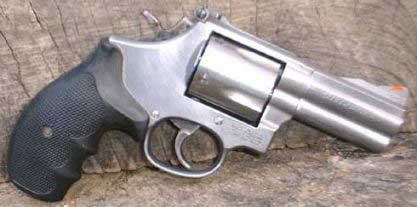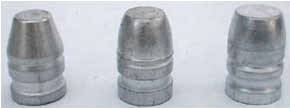|
The .44 Special is renowned for being the source of Elmer
Keith's inspiration, for giving rise to the .44 Magnum, and for serving as the
vehicle for Skeeter Skelton's pragmatic law enforcement loads. Historically, all
of these loads have centered around the use of 250 grain cast bullets. With the
ubiquitous nature of the .44 Magnum ammo, components, guns, etc. there's little
need to run the .44 Special at the Keith level, and for law enforcement
applications, it seems that most all departments have gone over to semi-autos
(mostly .40 caliber). So, while the Keith and Skelton loads are just as good as
they have always been, the original needs that they were designed to address
have been entirely satisfied by new guns and cartridges.
Life moves on.
Does this mean that the nearly century-old .44 Special is on
its death-bed? Hardly! In recent years there has been a surge of
interest in .44 Special belly guns, starting first with the Charter
Arms Bulldog, and then later with the Taurus 445 and Rossi 720,
followed by the S&W 696 and 396. I suggest that the short barrels
(generally 2 1/2" to 3") and lighter frames of these guns require
that we reconsider how we think of the .44 Special cartridge. These
little guns cannot handle the pressures of the Keith loads; even
Skeeter's load is a bit too stout (pressure-wise) for these light
guns, and only delivers modest velocities at best from these short
barrels. The solution to these shortcomings is a lighter bullet.
There is absolutely no need for a 250 grain bullet in these little
guns for trail use or personal protection from cougars, wolves,
skunks, etc. (if you're in big bear country, you need a bigger gun).
This article is intended to draw attention to the excellent level of
performance of the .44 Special from these belly guns using cast
bullets in the 200 grain range at 950-1000 fps. Now before anybody
scoffs at shooting "itty-bitty panty-waist bullets in a He-Man's
cartridge", let me remind you that the respected .45 ACP has been praised for precisely these ballistics (200 grain
bullets at 950 fps) for decades. This approach basically turns the .44 Special
belly gun into a .45 ACP with the safety, reliability and accuracy of a
revolver. And does it at pressures that won't turn that little belly-gun into an
alloy pretzel.
|
 |
|
The S&W 696 .44 Special. |
In general, the efficacy of moderate velocity cast bullets is a function of
meplat surface area, so lightweight wadcutters might be ideally suited for this
application (in stark contrast to the semi-auto world, where this blunt profile
would lead to feeding problems). There are two such wadcutters that readily come
to mind -- the Lyman 429348 (a 183 grain wadcutter), and the H&G #239 (a 193
grain WC). One can also induce bullet expansion from cast HP's at these speeds
if the bullets are cast soft enough. When working at this velocity level, I
prefer to cast HP's from 20-to-1 alloy (or softer). The 429215 GC-HP weighs 201
grains as it drops for the blocks when cast of 20-to-1 alloy. As an all-round
practice, plinking and field bullet for the .44 Special belly guns, it's hard to
think of a better one than the fine Saeco #428, a 200 grain plain-based
truncated cone (TC). One might also consider the various 205 grain .44-40
bullets in this category. With the exception of the 429215 HP (which was cast of
21-to-1) these bullets were all cast with WW alloy, sweetened with 1-2% added
tin. All bullets were sized .430" and lubed with my homemade Moly lube (equal
parts by weight Moly grease and beeswax).
For low pressure applications in the .44 Special, there are a number of good
powders available, but no powder outshines Unique. On top of this, Unique has
burning characteristics that make it very easy to light and provide top
velocities and excellent accuracy from the short barrels of these little guns.
The Lyman loading manual reports that 8.2 grains of Unique with 205 grain cast
bullets (Lyman 42798) generates 870 fps at a peak pressure of 14,000 CUP, and
the Hodgdon manual reports that 9.2 grains of Unique underneath a 180 grain JHP
generates 1000 fps with a peak pressure of 13,400 CUP. Therefore it was decided
to start these tests with 9.0 grain of Unique for the 183 grain Lyman 429348,
8.5 grain of Unique with the H&G #239 (193 grains), and 8.0 grains of Unique for
the 200-205 grain cast bullets to stay within these pressure guidelines.
The Lyman 429348 183 grain wadcutter loaded over 9.0 grains of
Unique left the little S&W 696 at an impressive 1085 fps, but delivered very
poor accuracy (8-12" at 25 yards). The H&G #239 193 grain WC loaded over 8.5
grain of Unique generated a respectable 1068 fps, but also produced poor
accuracy. Reducing these powder charges to 7.8 grains of Unique for both of
these bullets improved accuracy to where 5-shot groups at 25 yards were now
around 4"; better, but not good enough. I believe that these two bullets just
don't have enough bearing surface to shoot well in the polygonal rifling of the
696 at these speeds (they do just fine in normal "cut" rifling at typical
mid-range levels). Time to move on to other bullets.
Next up in these tests was the SAECO 200 grain truncated cone.
Loaded on top of 8.0 grains of Unique, the SAECO 200 TC delivered 981 fps and
very good accuracy, routinely turning in 5-shot 25 yard groups of 1 1/2"-2" (not
bad for a snubby!).
This has been my preferred field load for the 696 for a couple of years
now. It's an excellent grouse/bunny load, as the somewhat smaller meplat
of the SAECO TC kills well but doesn't tear up a lot of meat. When sighted
in for the Cor-Bon 180s, this load shoots pretty much to the sights.
I have long had a fondness for cast HP's due to the superb performance that I
have gotten over the years from the Keith and Thompson HP designs. Therefore, I
was very excited when I found a 429215 HP mould (the 215 grain Thompson GC-SWC)
since I felt that this might be just the ticket for the S&W 696. The GC would
allow it to be cast quite soft, and the weight was in the right range for the
loads that I was exploring. A batch was cast from 20-1 and loaded over 8.0
grains of Unique; velocities averaged 978 fps, but accuracy was disappointing. A
second batch was cast with recovered range scrap (BHN of about 7.5-8), and these
bullets were loaded over 7.8 grains of Unique. This combination produced 944 fps
and groups ran about 3 1/2" at 25 yards, an improvement, but not good enough.
Once again, I think this is the result of not enough bearing surface for the
polygonal rifling at this velocity, as this bullet shoots just fine in other
guns. It may also be a little too soft; I might be able to get it to shoot well
if cast of WW alloy, but then it would be too hard to expand at 950 fps. This
bullet is going to be saved for my longer barreled .44 Specials, with standard
"cut" rifling, where it should make a dandy varmint load.
Cramer produced a line of very well thought out and very well made moulds
back in the 1930s and 40s (they were bought out by Saeco in 1951, and SAECO
continues to produce a number of the old Cramer designs). Relevant to this
project is the Cramer 8A, a 220 grain plain-based RNFP that they made for the
.44-40. The Cramer 8A has a larger meplat than the typical RNFP of this period,
giving a .44 snubby the ability to deliver a hearty thump. The Cramer 8A was
cast with WW alloy (220 grains) and loaded on to of 7.5 grains of Unique. This
load produced 935 fps and exceptional accuracy, along with the best single group
of this series of tests (4 shots into just under 1" at 25 yards, with a called
flyer low, that opened the group up to 1 5/8"). This load printed about 5" above
point of aim when sighted in for the Cor-Bon 180s. While it will require
adjusting the sights to go from one load to the other, this load is now my
preferred field load for the 696 as a result of its broad meplat. SAECO still
produces this fine mould design.
When the discussion turns to meplat diameter, the name of LBT is bound to come
up. Pertinent to this discussion is their .44 230 WFN (wide, flat nose) bullet
design. Once again, these were cast of WW alloy (237 grains), sized .430" and
lubed with home-made Moly lube. They were loaded on top of 7.0 grains of Unique
and test-fired, producing 905 fps and good accuracy (1 3/4" groups at 25 yards).
This load also shot high (relative to the Cor-Bon 180s the gun was sighted in
for). Once again, excellent thump for an L-frame .44 Special snubby.
|
 |
|
Figure 2. Bullets that were found to
shoot well out of the S&W 696 .44 Special (l-r: the Saeco 200 grain
TC, the Cramer 8A 220 grain RNFP and the LBT 237 grain WFN). |
|
The key to getting good accuracy out of a cast bullet load from the S&W 696
seems to be choosing a bullet with sufficient bearing surface to minimize
slippage when the bullet gets engraved onto the polygonal rifling. Lighter
bullets tend to have less bearing surface, and hence are more prone to slippage.
The lighter bullets that were found to be accurate in these tests were those
that had longer than normal (for their weight) bearing surface, and included the
SAECO 200 grain TC, the Cramer 8A and the LBT 230 WFN. With the sharper "edge"
of standard "cut" rifling (found in other revolvers), this slippage is less
pronounced.
S&W recommends that their "Mountain Lite" (the 3" S&W 396 aluminum-framed,
titanium cylinder .44 Special revolver) should be loaded with lightweight
bullets to eliminate bullet slippage under the sharper recoil impulse that this
featherweight revolver generates. While I haven't worked with a 396 yet, I
suspect that the loads containing the Saeco 200 TC and the Cramer 8A would be
just the ticket. The LBT 237 grain WFN may be a little too heavy for the 396 (no
problem at all though for the steel-framed S&W 696).
While the performance of the large-framed .44 Special revolvers was optimized
years ago with Elmer's and Skeeter's loads built around 250 grain bullets, the
smaller, lighter .44 Special revolvers popular today are better served with
smaller, lighter bullets. While the 180-190 grain wadcutters delivered poor
accuracy in the polygonal rifling of the S&W 696, the 200-230 grain flat-pointed
bullets at about 950 fps are an excellent fit for the dainty little S&W 696, and
make dandy field loads. With bullets of sufficient bearing surface, this little
gun delivers superb accuracy. This is .45 ACP level of performance, with
revolver accuracy, safety, and reliability, and Cramer 8A and the LBT 230 WFN
provide all the meplat you could ever want (with no worries about feeding
reliability!). The .44 Special is a cartridge deserving of being revisited, and
it rewards those that do so.
|